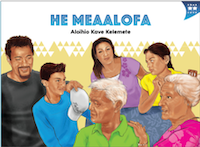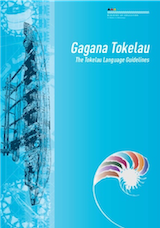You are here:
Overview
These teacher support materials accompany the six storybooks developed especially to support the Learning Languages Series resource Muakiga! An Introduction to Gagana Tokelau. Each story gives students opportunities to extend their language and cultural knowledge and to practise reading the target language of specific units in Muakiga!
These teacher support materials suggest how teachers can use the six storybooks to foster gagana Tokelau learning at levels 1 and 2, particularly in the context of the Muakiga! programme.
The teaching-as-inquiry cycle and the Newton et al. research
[1] on intercultural communicative language teaching underpin these teacher support materials. See:
Schools, ECE centres and education providers can order the set of six Muakiga! An Introduction to Gagana Tokelau storybooks from
Down the back of the chair. Enter item number MOE69797 into the search box.
Muakiga! An Introduction to Gagana Tokelau
Muakiga! is a resource in the Learning Languages Series. It provides a language-teaching programme that can be used by teachers, including those who do not speak gagana Tokelau or know how to teach languages. Muakiga! includes:
- twenty units of three lessons each
- a range of language suitable for years 7–10 at levels 1 and 2 of the curriculum
-
video and audio support to engage learners and demonstrate how fluent speakers
use the language
-
lesson plans that could be linked to opportunities for learners to enjoy reading
gagana Tokelau texts.
You can find Muakiga! online here.
Engaging students with texts
The teacher’s role is to mediate the interactions between the student and the learning materials and enable the student to meet their learning outcomes.
He Meaalofa
by Aloihio Kave Kelemete
This story supports Unit 14: Gāluega (Crafts) in Muakiga!
Schools, ECE centres and education providers can order this storybook from
Down the back of the chair. Use item number MOE69700 in the search box.
Learning goals
Encourage your students to set one or more of the following learning goals for their work with this storybook. The learning activities support these goals.
I will use gagana Tokelau to:
- read the story and understand it
- read the story aloud with clear pronunciation and reasonable fluency
- recognise and use some words and expressions in different contexts
- write texts with macrons and correct spelling
- talk or write about the story.
I will use English to:
- understand the story when it is read aloud
- talk about the content of the written and visual texts
- give examples of how Tokelau language and culture are organised in particular ways
- make connections with the language(s) and culture(s) I know
- research and present information about Tokelau culture and values in the story
- make connections with my learning in Unit 14 of Muakiga!
Language and Cultural Knowledge strands
The Language and Cultural Knowledge strands at levels 1 and 2 of Learning Languages in
The New Zealand Curriculum require students to:
- recognise that the target language and culture are organised in particular ways
- make connections with known languages and cultures.
The language and cultural features of the written and visual texts in the storybook are described here.
(a) Language Knowledge
The language features of the written texts include:
- instructions for making a kahoa with a plaited cord and a pā (pendant), for example, Tipi kehe te ata mai te tifa. / Cut the shape from the shell.
- expressions of time, for example, Kua kuata ki te hefululua. / It’s 11.45.; Kua tā te taimi mo te kaiga o te aoauli. / It’s lunchtime now.; Io, ko au ka fanatu nei! / OK, I’m coming now!
- vocabulary for household chores, for example, Hau hāuni fakalelei tō moega. / Come and make your bed properly.; Hau fakahūhū nā lākau i mua o te fale. / Come and water the plants at the front of the house.
- words that have different meanings according to whether a macron is used or not – for example, students know the word kāiga (family) from Unit 2 of Muakiga! Now they need to distinguish kāiga from kaiga / meal
- use of different verb forms, for example, hau / come (singular) and ōmamai or ōmai / come (plural)
- words transliterated from English, for example, tīpoti / teapot (jug); henitimita / centimetre; penimāka / marker pen
- expressions of place, for example, i mua o te fale / in front of the house; ki luga o te laulau / on(to) the table; [i loto] o te fale tāvale / in the garage – but note that i loto is omitted when the reference is to people, but included when the reference is to things
- use of words that have cognates in other languages, although the precise meanings of these may differ depending on the contexts in which they are used, for example, fale (house) in gagana Tokelau, vagahau Niue, faka lea-Tonga, and gagana Sāmoa; whare in te reo Māori.
(b) Cultural Knowledge
The cultural features of the written and visual texts include:
- the value of fakaaloalo (respect). This is expressed through the dad passing his knowledge of making meatalatalai (carved objects) to his son. Peato (the dad) is the expert and teaches Teao (his son) how to make a kahoa (necklace) to give to Teao’s mum as a present. Making the kahoa includes designing and shaping the pā (pendant), and plaiting the cord that holds the pā.
- the telling of time according to the 24 hour clock and the use of the metric system for measuring. These are comparatively recent additions to agānuku Tokelau, and show how contact with other societies influences how particular concepts are expressed in a culture. Refer to Muakiga! for more information on traditional forms of measurement (Unit 17, pages 387–389) and information on other ways to tell the time (Unit 16, pages 155–158).
- the making of a gift that Teao presents to his mother. This is an expression of alofa (love), shown also in the word meaalofa (present or gift), which literally means “some love”. The kahoa is a treasured and valued gift, which is presented to loved ones, in particular, to females, at special celebrations such as twenty-first birthdays and weddings.
- the extended family living in the same house, with grandparents having a parenting role.
- the value of māopoopo (inclusion), shown in the expectation that young people help with the housework and respond when they are asked to do particular jobs.
- the significant role of the eldest girl of a family, who is known as the fatupaepae (white stone). She has authority to make important decisions, and the right to tell her siblings what to do, for example, when Hilivēlia calls Teao to fold the washing and boil the jug.
Communication strand
Students learn to apply their language and cultural knowledge in different contexts and situations to communicate effectively for a range of purposes. As they become more effective communicators, students develop the receptive skills of listening, reading, and viewing and the productive skills of speaking, writing, and presenting or performing. These are summarised on the
Learning Languages Wallchart.
(a) The New Zealand Curriculum
The achievement objectives in learning languages,
levels 1 and 2 are generic.
In selected linguistic and socio-cultural contexts students will:
- receive and produce information
- produce and respond to questions and requests
- show social awareness when interacting with others.
(b) Gagana Tokelau: The Tokelau Language Guidelines
These
guidelines offer achievement objectives that are more specific. You could use any of the following level 2 achievement objectives to narrow the focus for your students to help them achieve particular competencies. In selected linguistic and socio-cultural contexts students will:
- understand and express concepts of amount, quality, and state (2.6)
-
make requests, give instructions, and respond to requests and
instructions (2.7).
(c) Muakiga! An Introduction to Gagana Tokelau
The Unit 14 learning outcomes for students are sharply focused. The following outcomes are relevant
to this story. Students will:
- express size
- make requests and give instructions
- respond to requests and instructions
- communicate about things they have made.
Cross-curricular links
Learners who are working at levels 1 and 2 in gagana Tokelau will be working at higher curriculum levels in other learning areas. Here are two examples of cross-curricular achievement objectives that could be linked to this story when you are planning links across curriculum learning areas.
The Arts, Level 3
Students will:
- explore some art-making conventions, applying knowledge of elements and selected principles through the use of materials and processes.
Technology, Level 3 (Technological Knowledge)
Students will:
- understand the relationship between the materials used and their performance properties in technological products.
Values
The story illustrates the values of:
- community and participation for the common good
- respect for themselves and others.
See page 10 in
The New Zealand Curriculum.
In addition, students will come to appreciate how the story reflects core Tokelau values of fakaaloalo (respect), māopoopo (inclusion), and vā feāloaki (relating to others). See pages 8–9 in
Gagana Tokelau: The Tokelau Language Guidelines.
[1] Newton, J., Yates, E., Shearn, S., and Nowitzki, W. (2009).
Intercultural Communicative Language Teaching: Implications for Effective Teaching and Learning. Wellington: Ministry of Education.
Back to top ^

